Preparing Shipments for International Freight Services: Everything You Need to Know
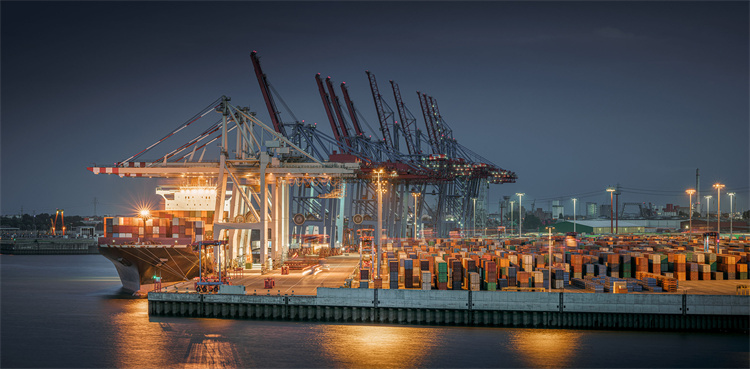
You must follow clear steps to get your shipment ready for international freight services. Good safety rules have helped lower ship losses to only 27 in 2024, even though there are more ships now. When you get your shipment ready, you help keep your goods safe and make shipping work better. Advanced supply chain solutions, like the ones from JUSDA, help you get your shipment ready and handle international freight services. Companies that use these solutions can have up to 30% lower inventory costs and fill orders better. If you do each step with care, you make your international shipment more likely to succeed and avoid common problems in international shipping.
Key Takeaways
Make sure your shipment follows all rules. Do not send restricted items. This helps you avoid delays or fines. Pack your goods in strong boxes. Use clear labels on each box. This keeps your items safe during long trips. Fill out customs documents like invoices and bills of lading. Make sure the information is correct. This helps your shipment move faster at the border. Use the right HS codes for your goods. Learn about customs duties. This helps you avoid extra costs and legal trouble. Think about getting cargo insurance. It can protect your goods from loss or damage. Pick a freight forwarder you can trust. They should have good technology and tracking tools. This helps you watch your shipment. Plan your shipment early. Use real-time tracking to find problems fast. This lets you fix issues quickly.
Shipment Eligibility
You need to make sure your shipment follows all shipping rules before you send it. Many countries have strong rules about what you can ship. If you break these rules, your shipment could be delayed or taken by customs.
Restricted Items
It is important to know which items are not allowed in international shipping. Some goods are banned or limited for safety or legal reasons. Explosives and flammable liquids are never allowed. Items like lithium batteries or firearms have special rules. The table below lists some common restricted items and examples:
Category | Common Examples | Travel Restrictions / Notes |
|---|---|---|
Pressurized containers | Spray cans, Butane, Propane tanks | Not allowed for travel |
Lithium batteries | Portable electronics, Ozone generators | Carry-on only; not in checked bags |
Firearms and ammunition | Handguns, Rifles, Ammunition | Checked bags only; must declare |
Explosives | Fireworks, Gunpowder | Not allowed |
Flammable liquids/solids | Fuel, Paints, Gas torches | Not allowed |
Household chemicals | Bleach, Insecticides, Aerosols | Not allowed |
Some items, like drug paraphernalia, are banned unless you have a medical prescription. It is illegal to import dog or cat fur products into the U.S. This can lead to big fines. Defense articles and military items need special export licenses.
Licenses and Permits
You need the right licenses and permits to ship some goods. Some items, like defense-related goods or dual-use items, need export licenses. Customs will check your paperwork at the border. If you do not have the right documents, your shipment could be delayed or sent back.
Studies show that shipment eligibility depends on exemption levels, export thresholds, and import thresholds. The table below shows important factors:
Factor/Aspect | Description |
|---|---|
Makes filing easier; last changed in 1989 | |
Export Thresholds | Full details for shipments over $2,500 (except Canada) |
Import Thresholds | Full details for shipments over $2,000 (or $250 for quota items) |
Courier Data Impact | More small packages now need careful classification |
Classification | Low-value shipments use one code and may skip detailed stats |
Always check the newest rules for your shipping route. Customs can change rules often, especially for items under trade or security actions. If you follow these steps, you can avoid problems and keep your shipment moving.
Packaging for International Freight Services

Secure Packing
It is important to use strong packaging for international freight services. Your goods need to be packed well for long trips and many stops. There are strict rules from groups like the International Maritime Organization and the International Air Transport Association. These rules tell you what materials to use, how to balance weight, and how to label and handle packages. If you follow these rules, your goods are safer. You can also avoid damage, delays, or fines.
Packing your goods tightly helps stop damage. Using bubble wrap or foam inserts can lower breakage. Drop tests show where your packaging is weak. Custom packaging, like molded inserts for glassware, can stop about 30% of damage. Strong boxes, like double-walled cardboard, and good padding keep cargo from moving or getting crushed. Your team should learn to pack well and check for empty spaces in boxes.
Labeling and Palletizing
Good packing and clear labels help your shipment move easily. Each box should have product details, quantity, and handling instructions. Clear labels help stop loss or damage and make inventory checks easier.
When you put goods on pallets, stack them in safe ways like columns or bricks. Use stretch wrap or straps to keep everything together. Pick pallets that fit your goods’ weight and size. Spread the weight out so cargo does not tip over. For LCL shipments, you must palletize your goods before shipping. Palletized cargo is measured and weighed in the warehouse, so add pallet weight to your shipping costs.
Tip: Teach your staff the right way to palletize and label. This helps prevent mistakes and keeps your goods safe during shipping.
Essential Documentation
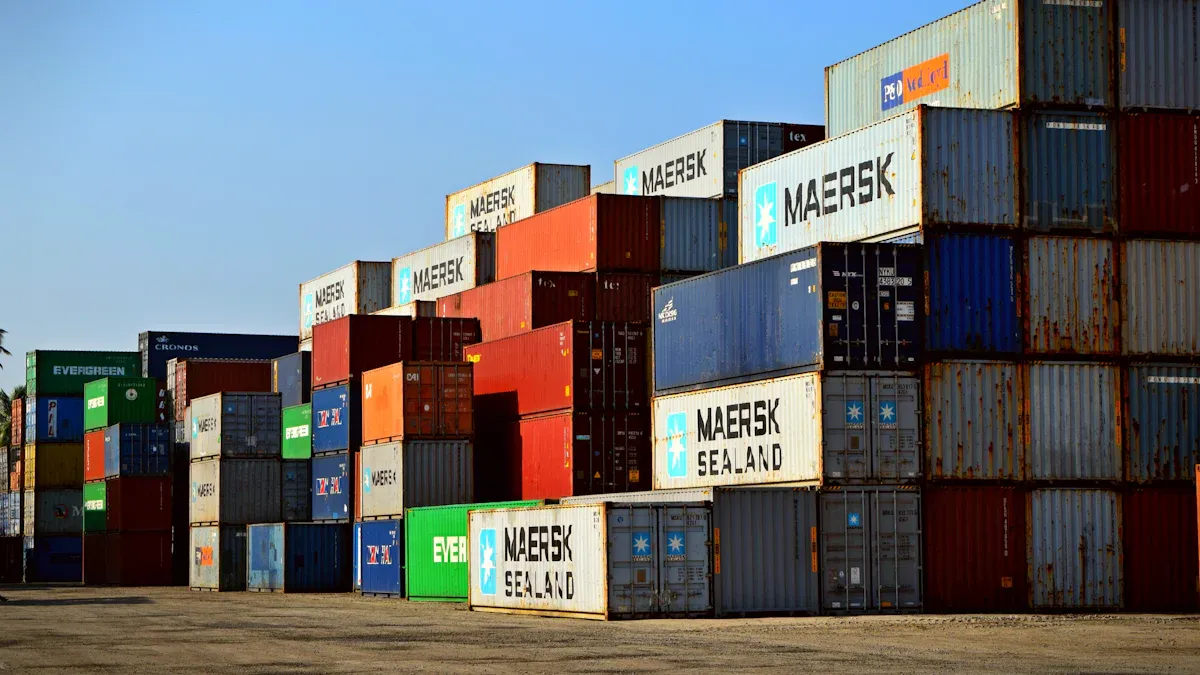
You need the right paperwork for international freight services. This helps your shipment move across borders without problems. Customs officials use these customs documents to check your shipment. They decide on duties and make sure you follow the law. If you forget a step or make a mistake, your shipment may be delayed. You might pay extra or your goods could get stuck at customs.
Note: Industry reports say poor paperwork causes most shipment delays. Mistakes like wrong addresses or missing customs documents cost a lot of money. Checking your paperwork and using digital tools can help you avoid these problems.
Commercial Invoice
The commercial invoice is a very important customs document. It shows what you are sending, who is buying it, and the price. Customs officials use it to check the value, origin, and type of goods. They use it to decide how much duty or tax you must pay.
A good commercial invoice should have:
Seller and buyer names and addresses
Description of goods and HS codes
Quantity, unit price, and total value
Country of origin
Payment terms and Incoterms®
If you leave out details or make mistakes, customs may delay your shipment. They might charge extra fees. Missing HS codes or wrong prices can even cause legal trouble. Always check your commercial invoice before you ship. Many companies use digital customs documents to lower mistakes and speed things up.
A correct commercial invoice helps you avoid shipment delays or problems at borders. It also makes payment and fixing disputes easier.
Bill of Lading
The bill of lading is another important customs document. It is a contract between you and the carrier. It is also a receipt for your goods and a title document. You need the bill of lading to get your shipment at the destination.
You must include:
Names and addresses of shipper and consignee
Description and quantity of goods
Shipping route and vessel details
Container numbers and seal numbers
Special instructions or handling notes
Customs officials use the bill of lading to match your shipment with other customs documents. If you put the wrong container number or address, your shipment could be delayed or lost. Many shippers now use electronic customs documents to avoid these mistakes.
Tip: Always check your bill of lading for mistakes. Even small errors can cause big problems at customs.
Packing List
The packing list is a customs document that shows what is in each box or pallet. It helps customs officials and warehouse staff check your shipment. The packing list should match the commercial invoice and bill of lading.
A good packing list includes:
Box Number | Description of Goods | Quantity | Weight | Dimensions | Marks/Numbers |
|---|---|---|---|---|---|
1 | LED Monitors | 10 | 15 kg | 60x40x30cm | A123 |
2 | Power Cables | 50 | 8 kg | 40x30x20cm | B456 |
You should always send the packing list with your customs documents. If you forget or make mistakes, customs may check your shipment more closely. This can cause delays or extra charges. Good paperwork helps you avoid these problems and keeps your goods moving.
Customs officials often check the packing list to confirm shipment details. Make sure your packing list matches all other shipping documents.
Common Documentation Errors and How to Avoid Them
Many shippers make mistakes in their customs documents. These mistakes can cause delays, fines, or even shipment seizures. Some common mistakes are:
Misclassifying goods or using the wrong HS codes
Listing wrong weights or quantities
Entering wrong addresses or container numbers
Missing or wrong supporting customs documents
Not checking declarations before sending
You can avoid these problems by:
Checking all customs documents before shipping.
Using digital tools and software to find mistakes.
Training your team on trade rules and customs needs.
Working with customs brokers or logistics providers for help.
A checklist and regular checks help you keep good paperwork and lower the risk of costly mistakes.
Customs documents are very important in international shipping. When you prepare your commercial invoice, bill of lading, and packing list with care, your shipment clears customs faster and avoids extra costs. Always treat your customs documents as the base of a successful international shipment.
Customs Compliance
HS Codes
You need to use the right HS codes for your goods. Customs officials use these codes to sort your shipment. They also decide what rules and taxes apply. The HS code system uses six numbers. Each part of the code means something different:
HS Code Component | Number of Digits | Description |
|---|---|---|
Chapter | 2 | First two digits show the product chapter |
Heading | 4 | First four digits give more detail |
Subheading | 6 | All six digits give full product information |
Most countries use this system for their shipments. The United States uses a longer code with ten numbers. The World Customs Organization changes these codes every five years. If you use the wrong code, your shipment could be late. You might pay more taxes or your goods could be sent back. The chart below shows how often codes change and how many numbers are used:
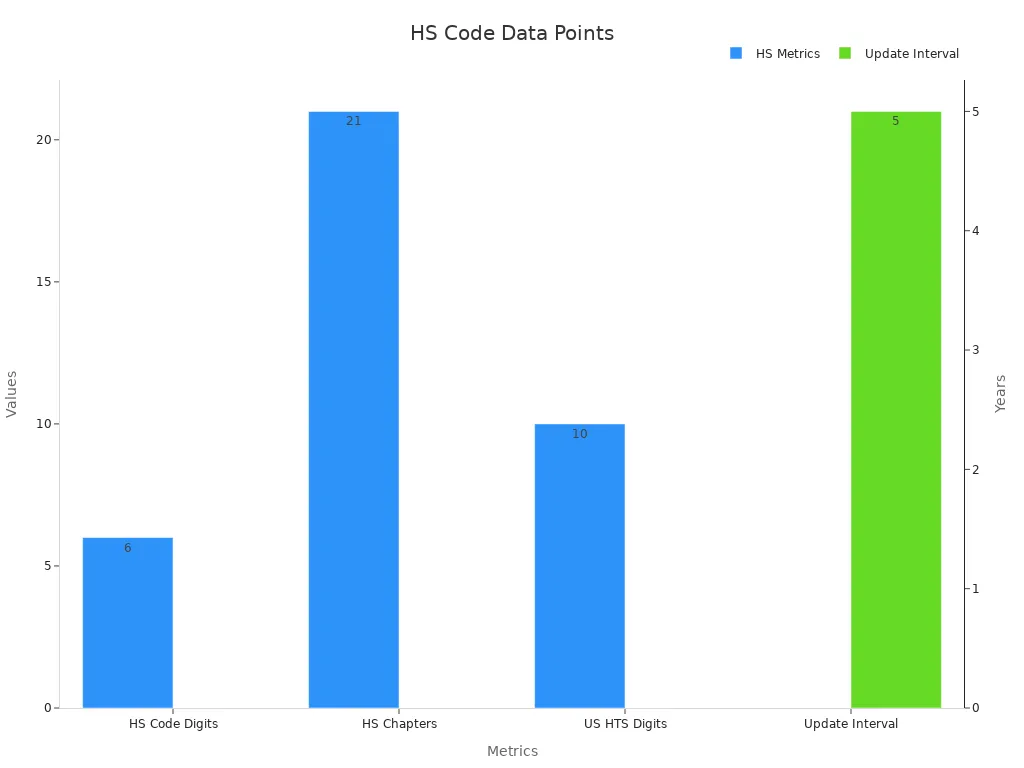
Duties and Taxes
You must handle customs duties and taxes the right way. These costs change your total shipping price. They also affect how fast your shipment gets through customs. If your customs documents are correct, customs can check your goods faster. The table below explains important points:
Aspect | Explanation |
|---|---|
Lets customs check goods and avoid problems | |
Proof of Origin | Can lower taxes if there is a trade deal |
HS Codes | Help set taxes and stop shipment delays |
Incorrect Classifications | Can cause wrong taxes and legal trouble |
If you know the customs rules and fill out the right customs documents, you will not have surprises. Your international shipping will go as planned.
Country Rules
Each country has its own customs rules and special needs. You should check these before you ship anything. The World Trade Organization collects facts about trade, taxes, and other rules. You can use the WTO Stats Dashboard to learn about these rules. Some countries check customs documents very closely. Others have special rules for some goods. If you follow all the customs rules and fill out your customs documents well, your shipment will pass through customs easily.
Tip: Always look at the customs documents and rules for your shipping route. This helps you stop delays and extra costs when shipping internationally.
Insurance and Shipping Costs
Cargo Insurance
You should think about cargo insurance for international shipping. Many things can go wrong during shipping, like fire or crashes. Bad packaging can also cause problems. Cargo insurance helps you if your goods get lost or damaged. Carriers usually only pay up to $500 for each shipping unit. This is often much less than what your goods are worth. Cargo insurance covers the rest and helps you worry less.
Most people who ship goods use cargo insurance. Almost all claims get approved, about 98%. It usually takes 10 to 30 days to get paid. The marine cargo insurance business is very big. In 2022, people paid $35.8 billion for insurance. Most claims happen because of fire, accidents, or damage from moving or storing goods. Sometimes machines break down or there are natural disasters. These risks show why having insurance is smart.
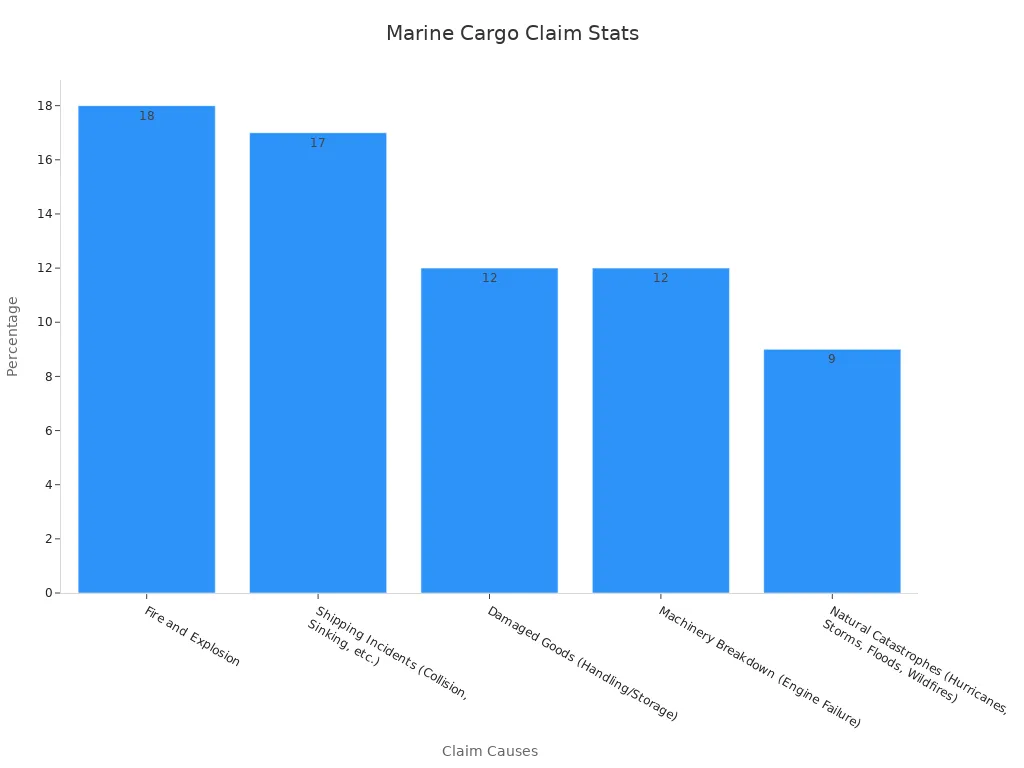
Tip: Using real-time tracking and smart packaging can help lower your risk. These tools might also help you pay less for insurance.
Cost Calculation
It is important to know how shipping costs are set. Shipping companies use special models and big databases to decide prices. They look at what you are shipping and how big or heavy it is. They also check the route and how you want to ship it. Shipping costs can change fast because of world events or supply chain problems.
In 2021 and 2022, shipping got much more expensive. This happened because there were problems with supply and demand. Many companies had to change how they shipped their goods. If you use strong packaging and get good insurance, you can protect your goods and save money. Always look at the newest prices and use tracking tools to watch your shipping costs.
Cost Factor | Impact on Shipping Cost |
|---|---|
Cargo type | Fragile or hazardous goods cost more |
Packaging size/weight | Heavier or larger packaging increases cost |
Route and distance | Longer routes cost more |
Mode of transport | Air is fastest but most expensive |
Choose a Shipping Partner: JUSDA
Freight Forwarder Selection
Picking the right freight forwarder makes shipping easier. You should choose a company with lots of experience and a big network. JUSDA is a good choice because it works with many industries, like electronics and cars. It has solutions for all kinds of shipments. When you pick a freight forwarder, check if they use new technology and have a good history.
Industry studies say companies that use technology do better. For example:
The 'Global Freight Forwarding 2024' report says technology helps companies work faster and get more business.
The 'Digital Freight Forwarder Market Size, Share, Trends, Growth Outlook' report says digital tools like AI, blockchain, and IoT make work easier, help you see your shipment, and save money.
JUSDA uses these tools to help you ship your goods. You can control your shipment better and have fewer delays.
Technology and Tracking
You need to track your shipment in real time to keep it safe. JUSDA’s Supply Chain Management Collaboration Platform and JusLink let you see your shipment at every step. These tools use AI, IoT, and cloud computing to connect everyone.
A real example shows why tracking matters. SEKO Logistics used tracking for a client with shipping problems. The client got their goods faster and on time, with 15-20% less waiting. JUSDA gives you the same help. You can see your shipment, fix problems fast, and keep your shipping on schedule.
Tip: Picking a good freight forwarder like JUSDA helps you avoid problems and makes shipping work better.
Schedule and Track Your International Shipment
Pickup or Drop-Off
You have to plan how your shipment will begin. You can ask for a pickup or take your goods to a shipping center. If you schedule early, you will not have last-minute problems. Many companies use route planning software now. This software updates routes right away. It helps drivers find the best way and change plans fast. When you plan orders and routes weeks before, drivers are ready. This also helps you avoid not having enough staff.
When you set delivery times, you have more control. You will have fewer missed deliveries and better routes.
AI route planning can make deliveries up to 40% faster. It can also cut fuel costs by 20%. For example, Quirch Foods used smart planning tools. Their drivers were on time 98% of the time. These tools also helped them drive 10% fewer miles. This saves money and lowers pollution.
You can check important numbers like total deliveries, on-time deliveries, and average delivery time. Good planning helps your shipment move quickly and safely.
Real-Time Tracking
Real-time tracking lets you see your shipment at all times. You always know where your goods are. This helps you find delays early and act fast. You can watch on-time delivery, lead time, and order accuracy with tracking tools.
A new study found that real-time tracking helps spot delays early. It also helps companies stick to their plans and have fewer delays. You can use platforms like JUSDA’s JusLink for real-time updates. This way, you always know if your shipment is moving as planned.
Tip: Real-time tracking lets you fix problems quickly and keeps your shipping smooth.
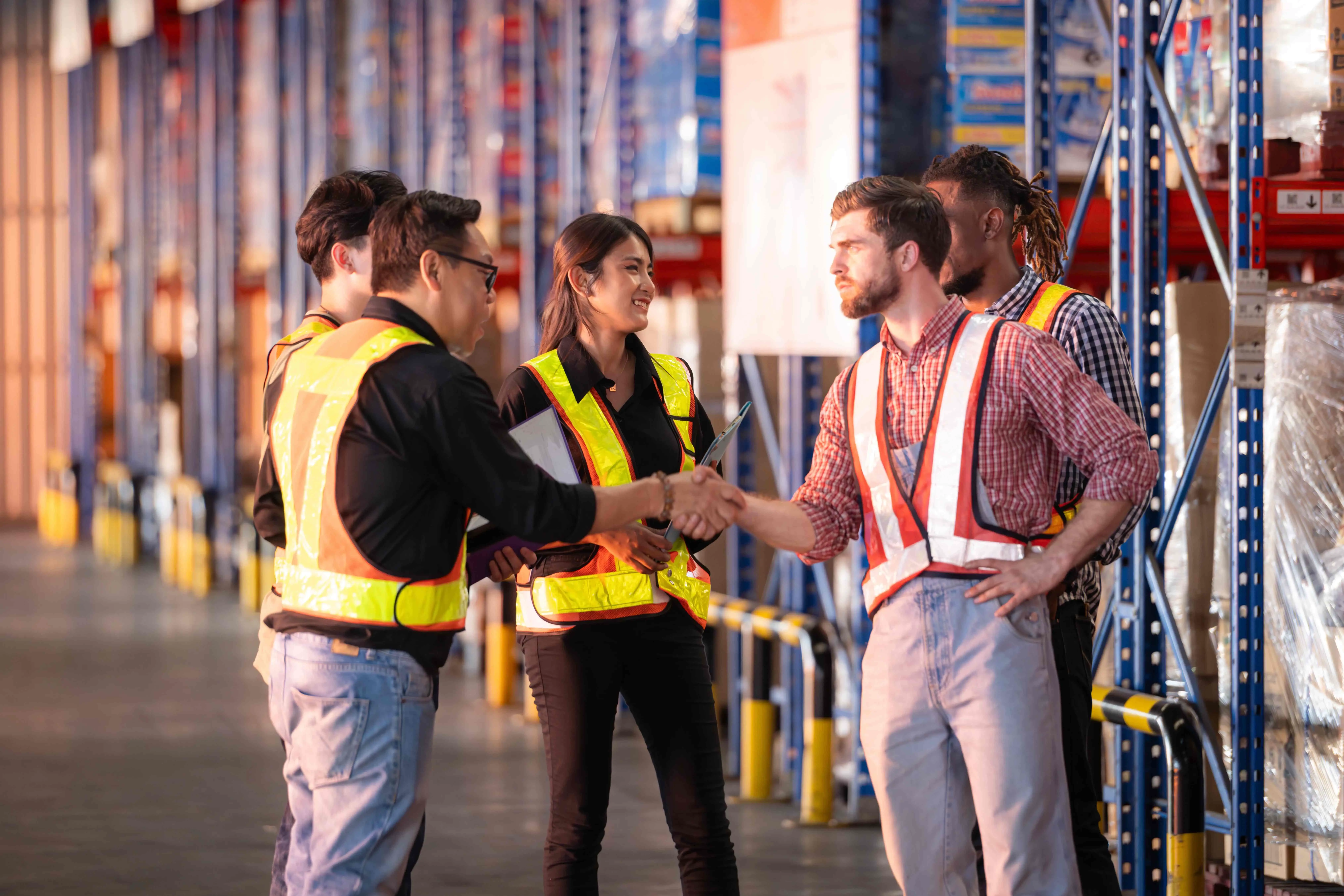
JUSDA Solutions
To provide you with professional solutions and quotations.
You can get your shipment ready for international shipping by doing each step with care. Always make sure you follow the rules, fill out all paperwork, and pick a good logistics partner. Smart supply chain solutions use AI to make shipping faster and help save money. For the best results, use this checklist:
Make sure your shipment is allowed
Pack your items safely
Get all your documents ready
Obey customs rules
Watch your shipment as it moves
See Also
Discover The Latest Trends In Sea Freight Logistics 2024
Comprehensive Insights Into Leading Global Logistics Firms
Effective Strategies To Reduce Logistics Costs Successfully
